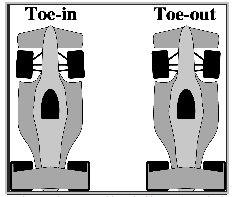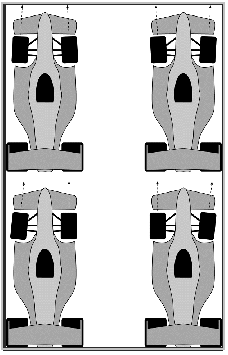| What's Hot! | Products/ Tools | EFI Tuning | Basic Tuning | Advanced Tuning | Chassis Tuning | Advertise with us |
UNDERSTANDING TOE
An Except from Grassroots Magazine:
When a pair of wheels is set so that their leading edges are pointed slightly towards each other, the wheel pair is said to have toe-in. If the leading edges point away from each other, the pair is said to have toe-out. The amount of toe can be expressed in degrees as the angle to which the wheels are out of parallel, or more commonly, as the difference between the track widths as measured at the leading and trailing edges of the tires or wheels. Toe settings affect three major areas of performance: tire wear, straight-line stability and corner entry handling characteristics. For minimum tire wear and power loss, the wheels on a given axle of a car should point directly ahead when the car is running in a straight line. Excessive toe-in or toe-out causes the tires to scrub, since they are always turned relative to the direction of travel. Too much toe-in causes accelerated wear at the outboard edges of the tires, while too much toe-out causes wear at the inboard edges.

So if minimum tire wear and power loss are achieved with zero toe, why have any toe angles at all? The answer is that toe settings have a major impact on directional stability. The illustrations at right show the mechanisms involved. With the steering wheel centered, toe-in causes the wheels to tend to roll along paths that intersect each other. Under this condition, the wheels are at odds with each other, and no turn results.
When the wheel on one side of the car encounters a disturbance, that wheel is pulled rearward about its steering axis. This action also pulls the other wheel in the same steering direction. If it's a minor disturbance, the disturbed wheel will steer only a small amount, perhaps so that it's rolling straight ahead instead of toed-in slightly. But note that with this slight steering input, the rolling paths of the wheels still don't describe a turn. The wheels have absorbed the irregularity without significantly changing the direction of the vehicle. In this way, toe-in enhances straight-line stability.
If the car is set up with toe-out, however, the front wheels are aligned so that slight disturbances cause the wheel pair to assume rolling directions that do describe a turn. Any minute steering angle beyond the perfectly centered position will cause the inner wheel to steer in a tighter turn radius than the outer wheel. Thus, the car will always be trying to enter a turn, rather than maintaining a straight line of travel. So it's clear that toe-out encourages the initiation of a turn, while toe-in discourages it.

With toe-in (left) a deflection of the suspension does not cause the wheels to initiate a turn as with toe-out (right).
The toe setting on a particular car becomes a tradeoff between the straight-line stability afforded by toe-in and the quick steering response promoted by toe-out. Nobody wants their street car to constantly wander over tar strips-the never-ending steering corrections required would drive anyone batty. But racers are willing to sacrifice a bit of stability on the straightaway for a sharper turn-in to the corners. So street cars are generally set up with toe-in, while race cars are often set up with toe-out.
With four-wheel independent suspension, the toe must also be set at the rear of the car. Toe settings at the rear have essentially the same effect on wear, directional stability and turn-in as they do on the front. However, it is rare to set up a rear-drive race car toed out in the rear, since doing so causes excessive oversteer, particularly when power is applied. Front-wheel-drive race cars, on the other hand, are often set up with a bit of toe-out, as this induces a bit of oversteer to counteract the greater tendency of front-wheel-drive cars to understeer.
Remember also that toe will change slightly from a static situation to a dynamic one. This is is most noticeable on a front-wheel-drive car or independently-suspended rear-drive car. When driving torque is applied to the wheels, they pull themselves forward and try to create toe-in. This is another reason why many front-drivers are set up with toe-out in the front. Likewise, when pushed down the road, a non-driven wheel will tend to toe itself out. This is most noticeable in rear-drive cars.
The amount of toe-in or toe-out dialed into a given car is dependent on the compliance of the suspension and the desired handling characteristics. To improve ride quality, street cars are equipped with relatively soft rubber bushings at their suspension links, and thus the links move a fair amount when they are loaded. Race cars, in contrast, are fitted with steel spherical bearings or very hard urethane, metal or plastic bushings to provide optimum rigidity and control of suspension links. Thus, a street car requires a greater static toe-in than does a race car, so as to avoid the condition wherein bushing compliance allows the wheels to assume a toe-out condition. It should be noted that in recent years, designers have been using bushing compliance in street cars to their advantage. To maximize transient response, it is desirable to use a little toe-in at the rear to hasten the generation of slip angles and thus cornering forces in the rear tires. By allowing a bit of compliance in the front lateral links of an A-arm type suspension, the rear axle will toe-in when the car enters a hard corner; on a straightaway where no cornering loads are present, the bushings remain undistorted and allow the toe to be set to an angle that enhances tire wear and stability characteristics. Such a design is a type of passive four-wheel steering system.
ATTENTION READER:
If you enjoyed the information and article you just read be sure to check out our newly released book with even more exciting photo's and information:How to Turbocharge and Tune your Engine

Want to know more about your particular Make and Model vehicle? All of these vehicles are covered in the tech, maintenance and repair articles found above. Enginebasics is the wiki or wikipedia of car part, repair, how to and tuning information. Let us be the class 101 for your automotive learning.
| Ford | General Motors GM | Pontiac | Jaguar | Land Rover | Nissan |
| Toyota | Honda | Lexus | Acura | Lotus | Scion |
| Infinity | BMW | Mercedes | Mitsubishi | Ferrari | Maserati |
| Lamborghini | Volks Wagen VW | Saab | Audi | Hyundai | Kia |
| Subaru | Mazda | Chevy | Volvo | Caddilac | Dodge |
| Chrylser | Daewoo | Porsche | Mercury | Freightliner | MG |
Individual Models
| Ford Mustang | Mitsubishi Eclipse | Mitsubishi Evo | Subaru WRX / STI | Dodge Viper | Chevrolet Corvette |
| Nissan Skyline | Honda S2000 | Nissan 350z | Toyota Supra | Chevy Camaro | Lotus Elise Exige |
| Honda Civic | VW Golf | Dodge SRT-4 | Eagle Talon | Acura Integra | BMW M3 |
| Nissan 240sx | Porsche 911 | Acura NSX | Honda Accord | Toyota Camry | Toyota MR2 |
| VW R32 | Dodge Truck | Mazda Rx7 | VW Jetta | Sand Buggy | Nissan Sentra |
For the latest Automotive news and stories visit the websites below |
Our feature Build: An AWD V6 Civic




